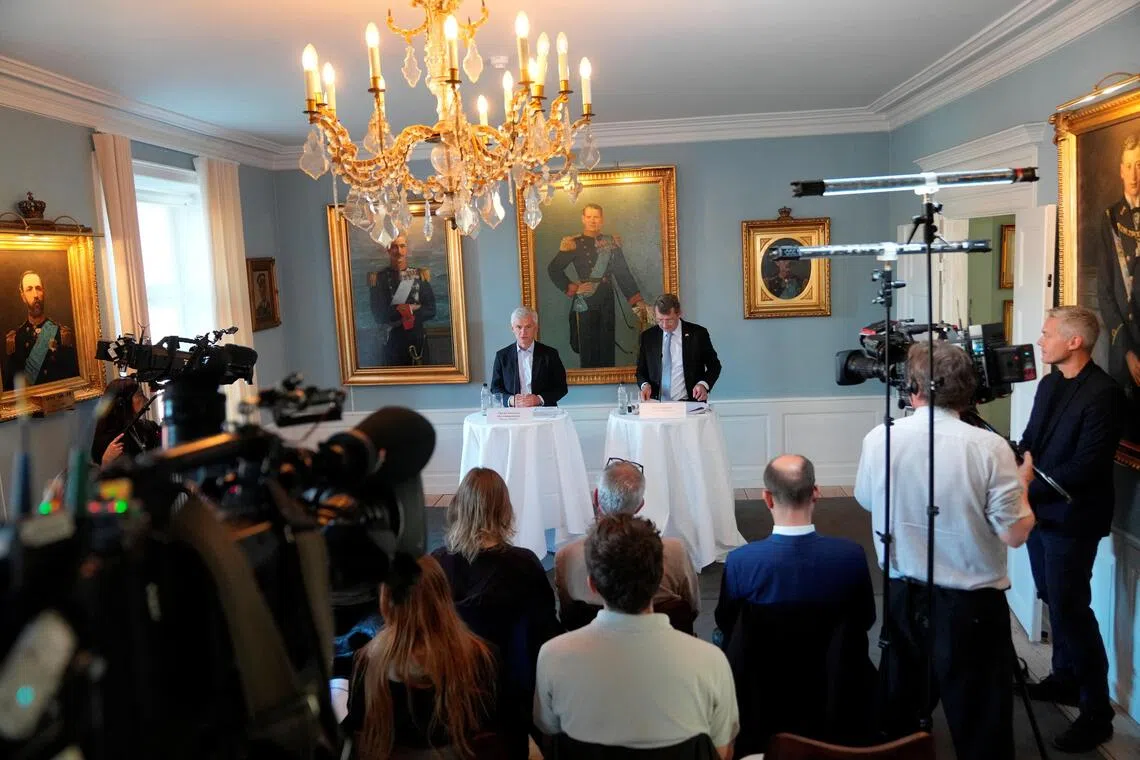Sailing on collision course: Denmark reports naval provocations by Russia in its straits
Sign up now: Get ST's newsletters delivered to your inbox

Danish Defence Intelligence Service director Thomas Ahrenkiel (left) and Denmark Defence Minister Troels Lund Poulsen delivering a press conference in Copenhagen, on Oct 3.
PHOTO: REUTERS
Follow topic:
- Russian warships engaged in aggressive actions in Danish straits, including collision courses and weapon targeting.
- Russia is suspected of hybrid warfare against Denmark, including GPS jamming and potential interference with oil tanker monitoring.
- Despite incidents, Denmark's defence intelligence claims there is no direct military threat, but hybrid attacks are increasing.
AI generated
COPENHAGEN - Russian warships have repeatedly sailed on collision courses, aimed weapons at Danish naval vessels, and disrupted navigation systems in Denmark’s straits that connect the Baltic Sea to the North Sea, its defence intelligence service said on Oct 3.
Such incidents risk unintended escalation, it said.
The Baltic region remains on high alert after incidents involving undersea cables, gas pipeline outages, airspace violations and drone sightings
Denmark, a staunch supporter of Ukraine in its war with Russia, has beefed up its military budget and committed to acquiring long-range precision weapons capable of striking targets inside Russia.
“We have seen several incidents in the Danish straits, where Danish air force helicopters and naval vessels have been targeted by tracking radars and physically pointed at with weapons from Russian warships,” Danish Defence Intelligence Service director Thomas Ahrenkiel told a press conference.
He said Russian warships had sailed on collision courses with Danish vessels during their passage through the straits.
Mr Ahrenkiel said a Russian warship has been anchored in Danish waters for over a week, suggesting possible interference from Moscow if Denmark tried to curb movements of Russia’s “shadow fleet” of tankers used to circumvent Western sanctions
In May, tensions escalated in the Baltic Sea when Russia deployed a fighter jet
The Danish straits, a busy international shipping route, see frequent movement of Russian military vessels that are typically escorted by Denmark’s navy.

A Russian naval vessel sailing through Denmark’s Great Belt Strait in August 2025.
PHOTO: REUTERS
Defence intelligence has also recorded Russian warships sailing through Danish straits with sonar and jamming equipment, according to Mr Ahrenkiel.
He said it was “highly probable” that they, on at least one occasion, had jammed signals and caused extensive GPS interference in Denmark.
Denmark’s intelligence service assesses that Russia is conducting hybrid warfare against Denmark and the broader West.
“Russia is using military means, including in an aggressive way, to put pressure on us without crossing the line into armed conflict in a traditional sense,” Mr Ahrenkiel said.
Moscow has repeatedly denied responsibility for hybrid attacks in Europe. President Vladimir Putin joked on Oct 2 that he would not fly drones over Denmark anymore, and described as “nonsense” the idea that his country would potentially target a Nato member.
The White House said on Oct 3 the report of Russian naval provocations against Denmark was a serious matter.
“It’s something the administration takes very seriously, and we are constantly monitoring it. The National Security Council here at the White House is in constant correspondence with our Nato allies, and the president speaks to many of them as well,” White House spokeswoman Karoline Leavitt told reporters at a briefing.
No direct military threat
Despite the incidents, defence intelligence emphasised that there was no direct military threat against Denmark.
However, Prime Minister Mette Frederiksen last week described recent drone incursions over Danish airports and military installations as a “hybrid attack” on the country.
Defence Minister Troels Lund Poulsen said investigations into the incidents were continuing, with no conclusions yet on the identity of the perpetrator.
Hybrid threats, which include sabotage, disinformation, espionage and cyberattacks, have been flagged as increasingly aggressive
Nato has strengthened its Baltic operations

